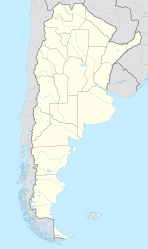Esquel
| Esquel | ||
|---|---|---|
| Town | ||

City Centre
|
||
|
||
| Location of Esquel in Argentina | ||
| Coordinates: 42°54′S 71°19′W / 42.900°S 71.317°WCoordinates: 42°54′S 71°19′W / 42.900°S 71.317°W | ||
| Country | Argentina | |
| Province | Chubut | |
| Department | Futaleufú | |
| Founded | February 25, 1906 | |
| Government | ||
| • Mayor | Sergio Ongarato (Cambiemos) | |
| Elevation | 563 m (1,847 ft) | |
| Population (2012) | ||
| • Total | 32,234 | |
| Time zone | ART (UTC-3) | |
| CPA base | U9200 | |
| Dialing code | +54 2945 | |
| Climate | Csb | |
| Website | esquel.gov.ar | |
Esquel is a town in the northwest of Chubut Province in Argentine Patagonia. It is located in Futaleufú Department, of which it is the government seat. The town's name derives from one of two Tehuelche words. One meaning "marsh" and the other meaning "land of burrs", which refers to the many thorny plants including the pimpinella and other herbaceous plants whose fruits, when ripe turn into prickly burrs that stick to the animals' skins and wool or people's clothes as a way of propagation.
The founding of the town dates back to the arrival of Welsh immigrants in Chubut in 1865. The settlement was created on 25 February 1906, as an extension of the Colonia 16 de Octubre, that also contains the town of Trevelin.
The city, the main town of the area, is located by the Esquel Stream and surrounded by the mountains La Zeta, La Cruz, Cerro 21 and La Hoya. La Hoya is known as a ski resort with good quality snow right through the spring. The Los Alerces National Park is 50 km (31 mi) northwest of the city.
Another important tourist attraction is the narrow-gauge train (with 75 cm between the rails), known as La Trochita locally and in English as The Old Patagonian Express after The Old Patagonian Express by Paul Theroux. It is said to be the only narrow-gauge long-distance train in operation and the southernmost railway in the world. The first fifty locomotives were made by Henschel & Son of Germany in 1922 and were originally modified to use fuel oil and steam. Later twenty-five locomotives were bought from the Baldwin Locomotive Works of Philadelphia.
...
Wikipedia


